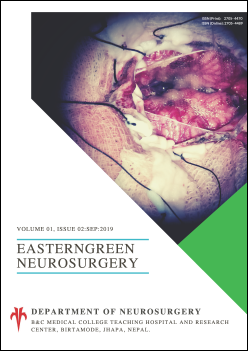3D rotational DSA: Diagnostic and therapeutic approach to cerebral aneurysms
DOI:
https://doi.org/10.3126/egn.v1i2.25726Keywords:
Digital subtraction angiography, 3D rotational technique, cerebral aneurysmsAbstract
Background and purpose: Digital subtraction angiography (DSA), a minimally invasive procedure for an exceptional visualization of cerebrovascular angioarchitecture, has become an important imaging technique for inclusive evaluation and therapeutic embolization. Our purpose is to share the importance of DSA for evaluation of cerebral aneurysms.
Material and method: A total of 148 patients with suspected intracranial aneurysm underwent digital subtraction angiography during January 2005 to December 2009. Preliminarily aortogram was considered in old age group (>50yrs) before supra-aortic angiography. Patient’s selection criterion included both ruptured and unruptured aneurysms. 3D rotational effect was applied for all complex cerebral aneurysms with unfavorable dome neck ratio. DSA was accomplished into 2- 6 standard projections for every vascular territory for optimal visualization and accurate evaluation of cerebral aneurysms.
Result: 21 were males and 48 were females. Age difference was ranged between 26-78 years with an average of 51.5years. Among 288 patients, total detected aneurysms were 480. 32 presented with SAH, 21 presented with headache and 14 patients came with cranial nerve dysfunction during admission. 3 had negative angiography irrespective to spontaneous subarachnoid hemorrhage. Delineation of aneurysmal neck improved with rotation effect of 3D DSA in 80% of patients. Parent vessel and its relationship to adjacent vessels was better demonstrated with rotational angiography in >50% of cases. Endovascular embolization was done in 80 patients in same setting.
Conclusion: DSA with 3D rotational technique is an essential radio-imaging tool for accurate characterization of cerebrovascular diseases and subsequently beneficial to elaborate on their potential treatment protocols.




